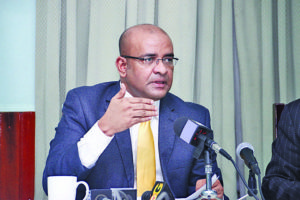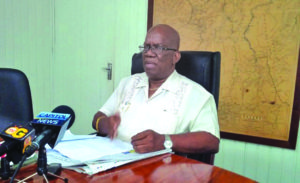Borrowing from multi-national partners has been a way of strategic economic development in Guyana for quite some time. But previous loans pale in comparison to recent plans to borrow approximately US$900 million and observers are worried.
Opposition Leader Bharrat Jagdeo on Saturday expressed much concern over the development. The trained economist and former President referred to the plan as a failed approach to national economic management and pointed out that the sum is almost equivalent to Guyana’s total external debt of G$236 billion by 2015.
“The shocking revelation… is serious cause for concern,” he stated. “We had however predicted this. The massive growth in the size of the national budgets, primarily on consumption, could not be financed by the hefty increase in taxation; so this hopelessly misguided [A Partnership for National Unity] APNU Government had to resort to large-scale borrowing.”
He added that this failed approach to national economic management was tried in the past and it led to a bankrupt country and resulted in devastating consequences for Guyanese.
“I am sure everyone would recall that the external debt was over 900 per cent of [Gross Domestic Product] GDP in 1992, which was reduced to 36 per cent of GDP in 2015. They plan to double it again within five years.”


According to Jagdeo, borrowing monies without feasibility studies, vision or plan will not solve Guyana’s economic woes. Instead, however, he expressed fears that this will have a long-term effect on the wellbeing of current and future generations of Guyanese.
It was announced that the Islamic Development Bank (IsDB) has, for the period 2018 to 2020, committed to providing Guyana with financial and technical assistance to the tune of US$900 million. This, it was made known, would be directed into the country’s key development areas to assist with its plans for continued social and economic development.
This disclosure was made by Finance Minister Winston Jordan during his address at the 43rd Annual Meeting of the IsDB Group in Tunisia. According to the Minister, this money will aid Government’s plans in a meaningful way, as it would give direct support to several Government programmes in many developmental areas.
“The Bank fielded a programming mission in December 2017, where a work programme for the three-year period 2018-2020 was formalised. Financing and technical assistance of about US$900 million will be directed to key development areas; including economic infrastructure, rural development, human development, and trade and competitiveness,” the Minister explained.
Jordan claimed that Government has been steadfast in its resolve to ensure growth in the economy. That resolve, according to him, resulted in economic growth averaging about three per cent between 2015 and 2017. The Finance Minister noted that this growth was achieved at a time when many of Guyana’s neighbours were facing low or negative growth rates and reduced standards of living.
“My Government has and continues to concentrate on a number of key strategic approaches for the economic well-being of our country. These include: strengthening national planning; building a robust oil and gas industry; and consolidating the macroeconomic fundamentals,” he had said. “But importantly also, the aim is to foster economic diversification and strengthen Private Sector capacity, among other (things).
Backpedalling
Shortly after, the Opposition Leader slammed Government over excessive borrowing. The Finance Ministry, through its Public Relations Officer Wanita Huburn, said Government has actually not received a loan but rather is being given access to a fund through which they can access monies. According to Huburn, the sum of US$900 million is “potentially available”.
“The Ministry of Finance notes the conclusion reached by some media houses that Guyana is a recipient of a US$900 million loan from the Islamic Development Bank (IsDB) and wishes to clarify that contrary to that conclusion, the IsDB has a resource envelope of US$900 million that is potentially available from which the Government of the Cooperative Republic of Guyana can borrow,” she stated.
According to Huburn, during the period November 27-29, 2017, the IsDB mounted a mission to Guyana to develop a medium-term work plan for the period 2018-2022. That work plan outlines a pipeline of projects that the Bank can support over the next five years.”
She noted that the potential areas of collaboration between the Bank and the Government of Guyana include the agriculture, energy, banking and finance sectors. In addition, the monies can be used for human and rural development.
“The current package of potential projects, consisting of proposed grant and loan operations is valued at approximately US$900 million. The Government is currently in the process of designing projects to commence accessing some portions of the IsDB resources,” she stated.
However, in a previous interview with this publication, Huburn had stated that 99 per cent of the US$900 million would be in the form of loans.



